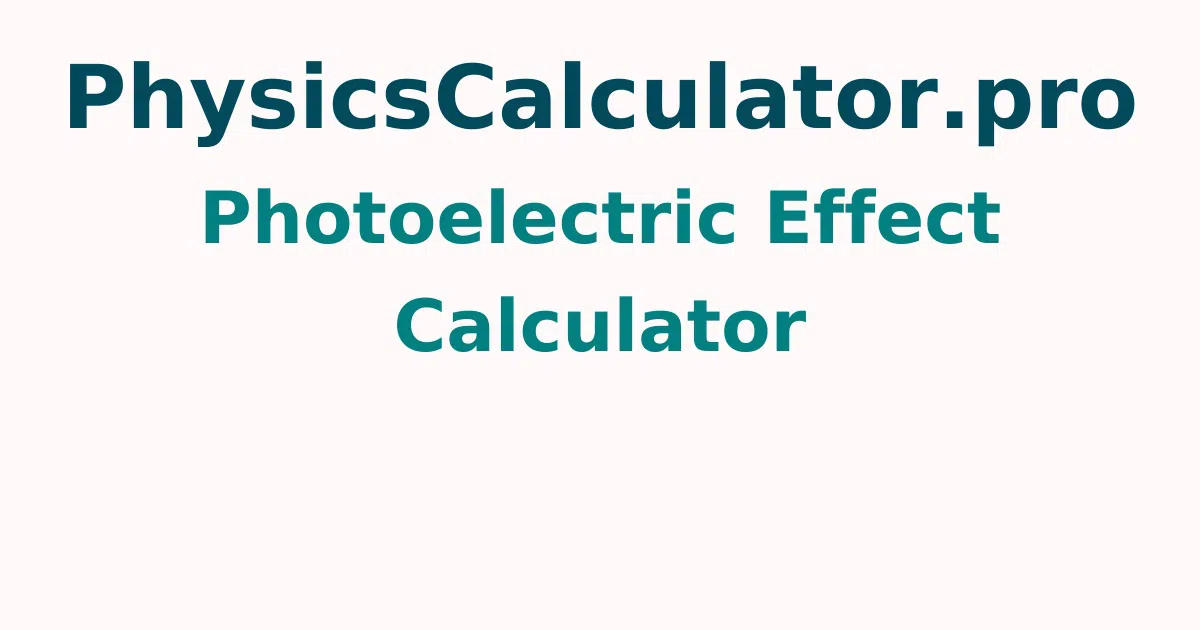Photoelectric Effect Calculator
To calculate the kinetic energy of ejected electrons, use the free Photoelectric Effect Calculator. To obtain the answer in a fraction of a second, simply enter the incident light frequency and threshold frequency and press the calculate button.
Photoelectric Effect - Definition
The photoelectric effect occurs when incoming light strikes a metal surface, causing photoelectrons to be emitted. The light frequency that is incident on it affects the emission of photoelectrons and kinetic energy.
The maximum kinetic energy of released electrons can be calculated using the formula KE = h. (f - f0)
f = (KE/h) + f0
f0 = h(f - KE)
- Where, KE = maximum kinetic energy
- f = frequency of the incident light
- f0 = threshold frequency of the surface
- h = placks constant and its value is 6.626 x 10^-34 Js
The minimum frequency of incident radiation below which photoelectric emission is not possible is known as the threshold frequency.
How to Calculate Kinetic Energy?
The steps for calculating the photoelectric effect are described below. To get the result, go through these procedures and follow them.
- Step 1: Make a note of the frequency of the incident light and the frequency of the threshold light.
- Step 2: Subtract the incident photon's frequency from the threshold frequency.
- Step 3: To assess the kinetic energy of electrons, multiply it by the Planck constant.
Requirements of the Photoelectric Effect
The photoelectric effect has three important requirements, which are as follows.
- Photoelectrons are emitted from the surface when the frequency equals the threshold frequency. As a result, the electron's kinetic energy is zero.
- If the frequency is less than the threshold frequency, there is no photoelectron ejection and thus no photoelectric effect.
- If the frequency exceeds the threshold frequency, photoelectrons and kinetic energy are released.
Photoelectric Sensor
The photoelectric effect is described in such a way that it appears to be very theoretical, although it has numerous practical uses. For example, photoelectric cells are used to detect light (in photoelectric sensors) or to collect the ensuing electron current (in solar cells). There are also the following applications
- Chemical examination of material
- Image technology (digital cameras)
- Photomultiplier (amplifies electricity from detected photon).
Photoelectric Effect Examples
Question 1: The threshold frequency in a photoelectric effect experiment is 200 Hz, while the incoming light frequency is 250 Hz. Determine the emitted electrons' maximum kinetic energy.
Given:
Threshold frequency f0 = 200 Hz
Incident light frequency f = 250 Hz
Maximum kinetic energy of emitted electrons is KE = h(f - f0)
KE = 6.626 x 10^-34(250 - 200)
= 6.626 x 10^-34(50)
= 3.313 x 10^-32
Hence, the kinetic energy is 10^-32 eV.
FAQs on Photoelectric Effect
1. What exactly is the photoelectric effect?
The photoelectric effect is the process of metals emitting electrons when exposed to proper frequency light, and the released electrons are photoelectrons.
2. What are some of the photoelectric effect's applications?
In solar panels, the photoelectric effect can be employed to create power. Motion and position sensors, as well as X-ray photoelectron spectroscopy, utilise it. In burglar alarms, photoelectric cells are utilised. Photoelectric sensors will be used in digital cameras to record and detect light.
3. What elements have an impact on the photoelectric effect?
The frequency and intensity of incident radiation, as well as the potential difference between metal plates and collectors, are all elements that influence the photoelectric effect.
4. How do you calculate the photoelectric effect?
KEe = hf - BE is the maximal kinetic energy of expelled electrons (photoelectrons), where hf is the photon energy and BE is the electron's binding energy (or work function) to the particular material.
